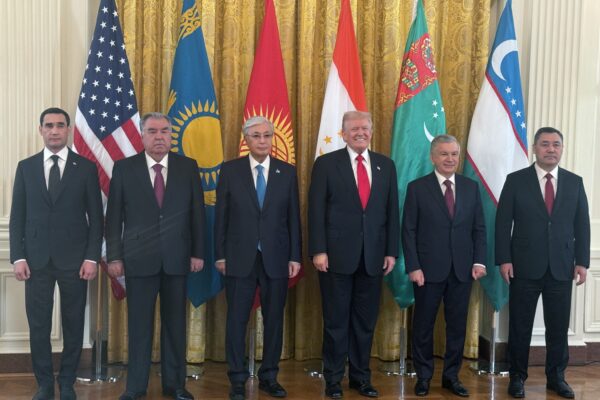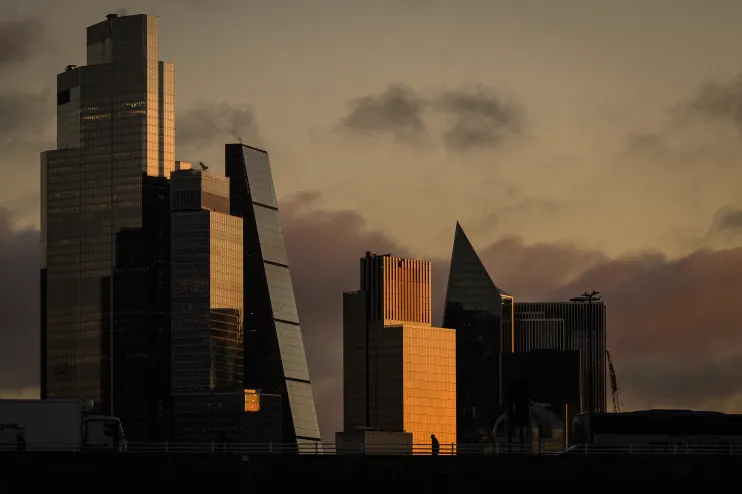Copyright thediplomat

Other than the Central Asian flags flying over the entrances to some of Washington D.C.’s fanciest downtown hotels, and greater-than-usual numbers of men in dark suits gathered, chatting in Uzbek, Russian or Kazakh, outside them, your average Washingtonian would have had little idea that on November 6 – for the first time ever – all five Central Asian presidents were being welcomed to the White House. But amid an increasingly acrimonious government shutdown, U.S. President Donald Trump welcomed the leaders of Kazakhstan, Kyrgyzstan, Tajikistan, Turkmenistan, and Uzbekistan individually to the Oval Office – and gathered with them for a 7 p.m. dinner in the East Room (not to be confused with the White House’s recently demolished East Wing). The landmark event stirred up genuine excitement among those in Washington who work on and with Central Asia, and among Central Asians long desirous of the faraway capital’s attention. The summit’s excessive focus on dealmaking made headlines, with particular emphasis on critical minerals and airplane purchases. [caption id=attachment_298718 align=aligncenter width=1280] Trump gestures during his working dinner with the Central Asia presidents on November 6. Photo: Shavkat Mirziyoyev / Facebook[/caption] The C5+1 is a little-noticed format but it has shaped U.S. policy toward Central Asia for a decade now. Bringing together the five Central Asian states and the United States, the format has seen consistent, though not always prominent, engagement, which deepened in the wake of the 2020 COVID-19 pandemic and again following the 2022 Russian invasion of Ukraine. Since 2015, the foreign ministers of the six countries have met almost annually, typically on the sidelines of the U.N. General Assembly. In 2022 a secretariat was established, a maturation of the format. In 2023, then-U.S. President Joe Biden hosted the first-ever C5+1 Leaders Meeting, also in New York amid the hustle and bustle of UNGA. As always, context is important. And it’s multilayered. There’s the international context to consider: Plans for a U.S. withdrawal from Afghanistan, which eventuated in August 2021, triggered a kind of soul-searching for U.S. Central Asia policy. Russia’s 2022 full-scale invasion of Ukraine has had myriad, and complex, effects on Central Asia; it has also reframed the region’s importance in U.S. eyes. Similarly, China’s all-consuming domination of critical mineral supply chains – and the strategic risks that present for the United States – motivated the launching in 2022 of the Minerals Security Partnership (MSP), in which Kazakhstan and Uzbekistan participate, and in 2024 the C5+1 Critical Minerals Dialogue. There’s the domestic contexts to consider, though these are less often remarked upon. The 2016 ascension to power of Shavkat Mirziyoyev in Uzbekistan unlocked a previously closed door to greater regional cooperation – and that regional cooperation amplified the possibilities for the C5+1 to make headway. Similarly, the 2019 change in leadership in Kazakhstan further enabled not-so-new, but newly embraced, ideas about cooperation to see the light of day. In a region characterized by autocratic politics, and long presidential terms, Tajikistan’s Emomali Rahmon is the only Central Asian president currently in power who was serving when the C5+1 was launched. Central Asia remains one of the least democratic regions of the world, with all five countries scoring in the “not free” category of Freedom House’s annual Freedom in the World ranking (disclosure: the author has served as an adviser on the ranking). But even as the Biden administration tried to muster the world’s democracies, it simultaneously pursued deepening relations with Central Asia, particularly through the C5+1. The second-coming of Donald Trump to the U.S. presidency has pushed points of friction, like human rights, far to the side. At the same time, the administration’s hyper-focus on domestic issues, like immigration, and its hollowing out of the U.S. government, including the slashing of the diplomatic corps and foreign aid, render U.S. diplomacy less capable from a human resources perspective – and more capricious. ***** The UNGA came and went in September 2025 without a C5+1 ministerial meeting. And although U.S. Secretary of State Marco Rubio had made mention of the format in statements after bilateral meetings with Uzbek and Kazakh officials earlier in the year, into late October it was unclear how the U.S. planned on marking the format’s 10th anniversary, rapidly approaching on November 1. On October 20, Rep. Sydney Kamlager-Dove (D-California) and Rep. Bill Huizenga (R-Michigan) – the ranking member and chair, respectively, of the South & Central Asia Subcommittee of the U.S. House of Representatives Foreign Affairs Committee – penned a letter urging the Trump administration to “host and personally attend a C5+1 Leaders’ Summit in Washington, D.C. this year.” Two days later, on October 22, a State Department official told The Diplomat, “We look forward to recognizing ten years of U.S.-Central Asian partnership through the C5+1 diplomatic platform and enhancing cooperation between our countries.” At that time, however, the official could not (or would not) confirm in what way the U.S. would celebrate the C5+1 anniversary. “We will let you know of any confirmed diplomatic engagements,” the official said. The following weekend, the Kazakh government broke the news: President Kassym-Jomart Tokayev had accepted Trump’s unreported invitation to “participate in the Central Asia–United States Summit to be held in Washington on November 6.” Public confirmations followed from the presidents of Uzbekistan, Kyrgyzstan, and Tajikistan. Speaking to The Diplomat on November 6, Kamlager-Dove said, “There are so many reasons why we should be at the table [with Central Asia] and I was scratching my head why this administration couldn’t understand that without the help of Congress,” in reference to the letter she penned with Huizenga, pushing for a presidential summit. [caption id=attachment_298717 align=aligncenter width=2048] The arrival of the Tajik delegation in Washington. Photo: Emomali Rahmon / Facebook[/caption] On November 5, Rubio hosted his Central Asian counterparts at the State Department for a welcome reception. In his remarks, Rubio concluded, “We oftentimes spend so much time focused on crisis and problems – and they deserve attention – that sometimes we don’t spend enough time focused on exciting new opportunities. And that’s what exists here now: an exciting new opportunity in which the national interests of our respective countries are aligned.” Rubio also stated his intention to visit all five Central Asian countries in 2026. If he follows through he’ll be the second U.S. secretary of state to complete the grand Stan slam,” after John Kerry’s historic 2015 trip through the region during which the C5+1 was launched. Earlier speakers in the evening, including Deputy Secretary of State Christopher Landau and U.S. Ambassador to India Sergio Gor, who is also serving as Trump’s special envoy to South and Central Asia, spoke effusively about new opportunities in Central Asia. “One of the real joys of working for President Trump in this administration is that he recognizes that foreign policy isn’t just about the same relationships that we have been developing for the last 80 or 100 years,” Landau said. “It’s a very big world, and there are many important parts of the world that have not had the attention that they deserve.” Landau and Gor recently returned from a trip that took them to Kazakhstan and Uzbekistan. Gor, in his remarks on November 5, said, “During our visit, we saw firsthand the remarkable progress our countries have made in expanding innovation, education, and business ties.” ***** As the summit approached, human rights organizations issued calls that, in some ways, come from a different era entirely; they also uttered a challenge that the Trump administration failed to rise to. “The Central Asia-US summit should ensure human rights is a key part of the agenda, especially as repression increases across Central Asia,” Hugh Williamson, Europe and Central Asia director at Human Rights Watch, said in a November 3 press release. “Participating countries should recognize that they risk recent social and economic progress if international partners seek stable environments elsewhere for engagement and investment.” Human Rights Watch went on to detail human rights concerns across all six countries, including the United States. Ben Linden, Amnesty International USA’s Advocacy Director for Europe and Central Asia echoed that perspective in a November 5 press release. “As authoritarian practices deepen across Central Asia, it is critical that President Trump urges the region’s leaders to pivot towards protection of human rights,” he said. “This summit offers a chance – and test – for the United States to demonstrate that it can play a positive role on human rights and defy expectations that the summit will reflect a purely transactional approach to the region.” ***** Those expectations were not defied. In fact, the Trump administration’s transactional preferences were on fully display, with savvy Central Asian businessmen just as keen to get in on a deal. Human rights went unmentioned, as did climate change, during the business conference hosted by the U.S. State Department at The Reach, located at the Kennedy Center, followed with a “Deal Zone” signing bonanza put on by the Commerce Department. The deals announced on November 6 ranged from aircraft to agricultural machinery, investments in the AI and banking sectors, and a tungsten mine in Kazakhstan. The Kazakh, Uzbek, and Tajik national carriers all signed deals to purchase Boeing aircraft. Uzbekistan confirmed it would purchase 22 total 787-9 Dreamliners, fleshing out a September deal that stipulated the purchase of 14 aircraft, with the option of eight more. Kazakhstan’s Air Astana signed a deal to purchase up to 15 787-9 Dreamliners. And Tajikistan’s Somon Air will buy up to 14 Boeing planes, including four 787s and 10 737 MAX airplanes. Other notable deals included American companies like John Deere and Starlink. By number (not necessarily value), Kazakhstan and Kazakh companies appeared to sign the most deals this week, followed by Tajikistan, Uzbekistan, and Kyrgyzstan. No deals for Turkmenistan, apparently. Many of the deals involve Central Asian purchasing of U.S. equipment and expertise. Where there is talk of trade with Central Asia, mention of the Jackson-Vanik amendment is not far off. In his closing remarks, Senator Steve Daines, a Republican from Montana, who served effectively as the conference’s MC, said, “I’m working with bipartisan partners in Congress to repeal the outdated Soviet-era Jackson-Vanik trade restrictions.” The Jackson-Vanik amendment to the Trade Act of 1974 rendered certain countries ineligible for normal trade relations with the United States due to restrictions on emigration, specifically that of Soviet Jews seeking to leave the USSR. Although the Soviet Union collapsed in 1991, Jackson-Vanik lived on. It’s a sore point for the Central Asian countries — Kazakhstan, Uzbekistan, Tajikistan, and Turkmenistan — still technically under its restrictions (Kyrgyzstan was permanently exempted in 2002.) The countries of Central Asia have all been granted conditional normal trade relations on an annual basis for decades now. Arguably, the amendment has not hampered the expansion of trade; every deal signed on November 6 came into being despite Jackson-Vanik’s continued existence. But it is a “Cold War relic,” Kamlager-Dove told The Diplomat. “It sucks the oxygen out of the room when you’re talking about trade.” Perhaps most importantly, “it’s a stigma that these countries are trying to do away with.” On November 4, committees in both the House and Senate introduced bills titled “To authorize the extension of nondiscriminatory treatment (normal trade relations treatment) to products of certain countries.” The full texts are unavailable at present, but presumably these are the bills of which Daines spoke. Such initiatives have been introduced before, most recently in 2023 by U.S. Senators Chris Murphy (D-Connecticut) – a co-sponsor on the current Senate bill – and Todd Young (R-Indiana). But past efforts have not made it out of committee, let alone to a vote or into law. [caption id=attachment_298716 align=aligncenter width=4080] Senator Steve Daines addressing the C5+1 Business Forum. Photo by Catherine Putz.[/caption] There is more to the Central Asia-U.S. relationship than trade and critical minerals, although those are clearly the areas of most interest for the Trump administration. As the Central Asian leaders arrived in Washington, among their many meetings were visits with members of Congress, including Kamlager-Dove. “Obviously an underlying conversation was the Jackson-Vanik amendment repeal and critical minerals, but we had a wholesome conversation about a number of other priorities I think that are equally important,” Kamlager-Dove told The Diplomat. In her conversation with Uzbek President Shavkat Mirzyoyev, Kamlager-Dove said they discussed soft power – particularly sports diplomacy given the North American hosting in 2026 of the FIFA World Cup at which the Uzbek national team will make its first appearance – alongside issues as varied as eradicating forced labor and increasing the presence and roles of women in government. With Kazakh President Kassym-Jomart Tokayev, she discussed Kazakhstan’s contribution to U.N. peacekeeping forces, the country’s work enforcing sanctions on Russia, and even the importance of free media. “With the Turkmen [President Serdar Berdimuhamedov] we talked about the arbitrary visa restrictions that the Trump administration has imposed on Turkmenistan, specifically student and exchange visas – this limits our people-to-people ties and hurts both of our countries,” Kamlager-Dove said. Very few of these issues were raised during the segments of the business forum to which press were invited. [caption id=attachment_298715 align=aligncenter width=2048] Kazakh President Tokayev mirroring U.S. President Trump's favorite hand gesture in the Oval Office. Photo: Aqorda / Facebook[/caption] Of the five current Central Asian presidents, only Uzbekistan’s Mirziyoyev has been treated to a White House visit before, in 2018 during Trump’s first term. That made the scenes on the evening of November 6 remarkable: the Central Asian presidents each were greeted by Trump individually in the Oval Office. Afterward, the presidents and other top officials sat for dinner – which Trump promised would be a “short one” – during which Trump read brief prepared remarks and each of the Central Asian presidents delivered their own. “Sadly, previous American presidents neglected this region completely,” Trump said, ignoring the fact that his predecessor was the first to meet with all five Central Asian presidents in 2023. Trump remarked on his administration’s efforts to broaden critical mineral supply chains and noted a positive meeting with Chinese leader Xi Jinping, while also commenting favorably about Japan’s new prime minister as well as his recent visits to South Korea and Malaysia. He then emphasized the investments “pouring” into the United States, crediting his tariffs. The U.S. president pivoted back toward the region, though Trump kept himself at the center, remarking on the recent peace agreement between Armenia and Azerbaijan and their launching of a trade route named after him. Then he announced that some of the gathered countries would be joining the Abraham Accords – a set of agreements normalizing relations between Israel and several Arab states starting in 2020. But all five Central Asian countries already have diplomatic relations with Israel, and have for decades: Kazakhstan, Kyrgyzstan, Tajikistan, and Uzbekistan, established relations with Israel in 1992, and Turkmenistan did in 1993. It’s unclear what their joining the accords would actually mean. (A reporter asked for more detail but paired the question with one about the U.S. government shutdown, leading to Trump going off on a tangent about illegal immigrants receiving healthcare – they don’t – before the reporter prompted him to answer the first question. Trump then deflected to Rubio, who argued that the accords are about “partnership” more than diplomatic recognition.) When it came to the Central Asian presidents, they each heaped praise on Trump – at times repeating catchphrases the U.S. president himself has used. Tokayev noted Trump’s “landslide” victory in the 2024 presidential election (Trump won 49.8 percent of the popular vote), and went on to compliment Trump’s policies as “wise and bold,” and sure to bring on a “new golden age.” Mirziyoyev told Trump that in Uzbekistan, the U.S. president is referred to as the “president of the world.” Although Trump urged the press in the room to stick to the topic at hand – Central Asia – only the first two questions were truly about the region. A Kazakh reporter asked if Trump would visit Kazakhstan, and another Central Asian reporter inquired about the Jackson-Vannik amendment. None of the Central Asian presidents, whose backs were to the press pen, responded to questions. And unlike in 2023, when the C5+1 Leaders' Meeting resulted in the New York Declaration outlining the platform's achievements and plans there was no joint statement produced in 2025. [caption id=attachment_298714 align=aligncenter width=1280] A C5+1 Dinner in the White House's East Room on November 6. Photo: Shavkat Mirziyoyev / Facebook.[/caption]



